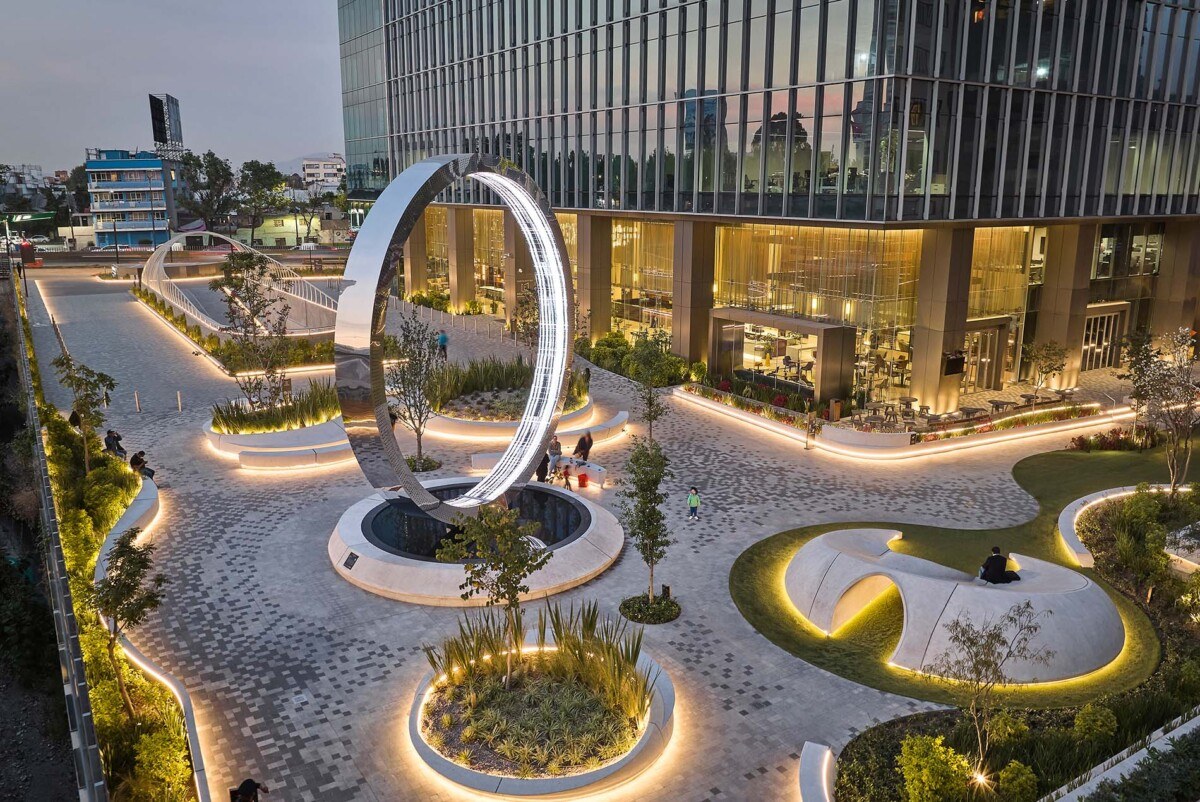
The team’s vision imagines the campus as an artificial topography where district edges blend seamlessly with the adjacent landscape, and rooftop terrace gardens unfold into lush meadows.
The campus edge serves a dual function as both a recreational space and a facilitator for auxiliary functions, logistics, data centers and parking.
At the heart of the site, a dense, cocooned environment rises above the landscape, forming a symbolic skyline for the research community.

The plan incorporates the essence of the Arabian desert’s forms, patterns and colors into its architectural design. By seamlessly blending landscape elements, photovoltaics and skylights, the design create a protective layer that serves several purposes. It shields the campus from harsh northern winds, provides shade for public spaces and contributes to the overall sustainability of the project.
This thoughtful integration enhances the campus’s environmental performance while cultivating a comfortable microclimate tailored for the research community.

HOK’s design process began with a careful examination of the desert landscape, from which the team abstracted organic forms into a logical, modular architectural vocabulary.
The team’s early discovery that the site once contained dune landforms similar to the proposed building massing reinforced the biomimetic concept and strengthened connections to the environment and culture.
Drawing further inspiration from diverse sources—including a local artist’s installation of stacked supermarket crates in the desert and Maya Lin’s scientifically derived topographies—the team designed a campus that subtly echoes the interplay of light and shadow while providing a functional, highly adaptable space.

The campus departs from the traditional research campus model of an isolated enclave.
Instead, inspired by Christopher Alexander’s influential diagram of Cambridge University’s integrated urban fabric, it is laid out as a grid of permeable courtyard clusters. These clusters interconnect through a latticed network of pedestrian pathways and public spaces, seamlessly blending academic and communal areas.


Sculpted into curved, terraced forms that evoke wind-blown sand dunes, the building masses shield the interior from harsh sunlight. Intensive studies of wind velocity and aerodynamics informed the optimization of these forms for the local climate, creating a protective microclimate within the biotech campus.
This approach creates a flexible framework that accommodates a diverse blend of medical, agricultural and industrial research facilities within modular wings. Individual labs or wings can be added, removed or reconfigured without disrupting the overall layout or functionality, allowing the campus to evolve over time.

A network of covered pedestrian walkways connects public plazas and courtyards. These corridors, resembling narrow desert slot canyons, are lined with amenities, educational spaces and areas for interaction between researchers and the public.
The campus’s heart is the “agora,” a central gathering space named after ancient Greek public squares. The agora acts as a hub for community dialogue and innovation. Moving outward from the agora, the campus gradually transitions into more open, park-like spaces blurring the boundaries between the built environment and the natural landscape.

The campus layout features a vertical stacking of functions, with public spaces at ground level, research facilities in the middle, and mechanical and agricultural zones on the rooftops.
Sky gardens and amenity decks are interspersed throughout the upper levels.
Parking and service zones are tucked discreetly into “dunes” along the perimeter.




HOK’s campus plan recognizes the pivotal role of landscape in integrating the development into its surroundings. Public realm and green spaces serve as connective tissue, mediating between the research center and the adjacent hospital and university precincts.
By prioritizing landscape as a unifying element, the design creates a cohesive, harmonious urban environment. This fosters a sense of continuity and interconnectedness among the various institutions and neighborhoods.
The strategic use of public spaces and greenery makes the area more attractive while blending the campus into Riyadh. This facilitates collaboration and knowledge-sharing among researchers, healthcare professionals and academics.


